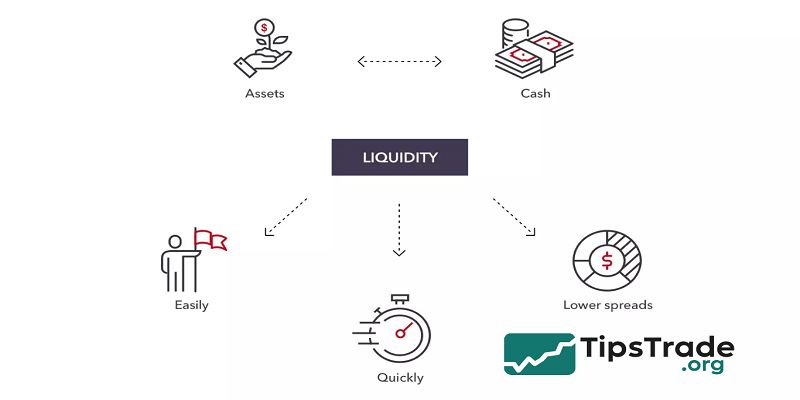Stock liquidity is one of the most important, yet often misunderstood, aspects of financial markets. It refers to the ease with which a security can be bought or sold without causing significant price fluctuations. In a liquid market, investors can trade efficiently at stable prices, while illiquid markets are prone to volatility, wider spreads, and the possibility of mispricing. In an increasingly algorithmic environment, understanding stock liquidity has become central to portfolio construction, trading strategies, and risk management. Join tipstrade.org for in-depth analysis on the meaning, determinants, measurements, and implications of liquidity – backed by data, empirical research, and experts.
Understanding Stock Liquidity

Stock liquidity is commonly defined as the ability to trade large quantities of a stock quickly, at low cost, and with minimal price impact. In other words, a liquid stock allows investors to enter or exit positions with limited friction.
Components of Liquidity
Market practitioners generally break down liquidity into four key components:
- Tightness – how close bid and ask prices are (reflected in bid–ask spread).
- Depth – the available volume of orders on both sides of the market.
- Immediacy – how quickly orders can be executed.
- Resiliency – how rapidly prices return to equilibrium after a trade.
A stock with narrow bid–ask spreads, high daily trading volume, and deep order books exhibits strong liquidity. Conversely, thinly traded small-cap equities typically demonstrate low liquidity, leading to greater price volatility.
Market Microstructure Perspective
- From a microstructure standpoint, liquidity results from the continuous interaction between buyers and sellers, intermediated by market makers and algorithmic traders.
- According to Madhavan (2000, Journal of Financial Markets), market design, trading mechanisms, and information asymmetry jointly influence liquidity formation.
- This theoretical foundation highlights that liquidity is not a static property—it evolves dynamically with market conditions.
See more:
- Long-Term Stock Investing: Benefits and Key Principles to Understand
- ETF Investing: The Ultimate Guide for Beginners
- Day Trading Stocks: Benefits, Risks, and Effective Investing Strategies
- Investment strategies stock price: A Comprehensive Guide for Investors
Factors Affecting Stock Liquidity

Several structural and behavioral factors determine how liquid a stock is on any given day.
Trading Volume and Market Capitalization
- Trading volume remains the most visible indicator of liquidity.
- Larger firms, such as Apple or Microsoft, typically attract more institutional and retail activity, resulting in tight spreads and abundant market depth.
- Studies from the CFA Institute show that the top 10% of U.S.
- equities by market capitalization account for over 80% of total trading volume.
Bid–Ask Spread and Transaction Costs
- The bid–ask spread—the difference between what buyers are willing to pay and what sellers are willing to accept—is an inverse measure of liquidity.
- A narrow spread signals high liquidity, while a wide spread implies greater trading costs and limited participation.
- According to NASDAQ market data (2024), large-cap stocks maintain an average spread of less than 0.05%, whereas microcaps often exceed 1%.
Information Transparency and Disclosure
- Companies that maintain transparent financial reporting, frequent earnings guidance, and clear investor communication tend to exhibit higher liquidity.
- Research from The Accounting Review (2019) found that enhanced corporate disclosure can reduce information asymmetry, thereby lowering spreads and improving trading efficiency.
Macroeconomic and Market Sentiment Factors
- Liquidity is sensitive to macro variables—interest rates, inflation expectations, and geopolitical risk.
- During crisis periods, such as the 2008 Global Financial Crisis or the COVID-19 shock in 2020, liquidity evaporated across asset classes as investors sought cash and safety.
- Thus, liquidity risk has a systemic dimension, intertwined with market confidence and credit conditions.
Measuring Stock Liquidity
Measuring liquidity accurately is complex, as it encompasses multiple dimensions. Analysts and researchers use both direct and indirect measures.
Quoted and Effective Bid–Ask Spreads
- Quoted Spread: The simplest proxy, calculated as (AskPrice−BidPrice)/Midpoint.(Ask Price – Bid Price) /Midpoint.(AskPrice−BidPrice)/Midpoint.
It reflects the cost to trade instantaneously. - Effective Spread: Measures the actual execution cost relative to the midpoint price when a trade occurs. It accounts for price improvement or slippage, offering a more realistic depiction.
- For instance, if the bid is $100 and the ask is $100.10, the quoted spread is 0.10%. If a trade executes at $100.05, the effective spread is 0.05%.
Amihud Illiquidity Ratio (Amihud, 2002)
- The Amihud ratio estimates the price impact per dollar of trading volume:
- ILLIQ=∣Rt∣VolumetILLIQ = \frac{|R_t|}{Volume_t}ILLIQ=Volumet∣Rt∣
- A higher value indicates illiquidity.
- This measure is widely used in empirical finance for cross-sectional liquidity comparisons.
Turnover Ratio
- Defined as trading volume divided by shares outstanding, the turnover ratio gauges trading activity intensity.
- High-turnover stocks typically exhibit greater liquidity and investor interest.
Market Depth and Order Book Analysis
- Modern exchanges provide Level II data, allowing analysts to examine the number and size of resting orders at different price levels.
- A deep order book implies greater absorptive capacity against large trades.
Composite Indices
- Academic research often employs composite measures such as the Pastor–Stambaugh liquidity factor (2003) or the LIQ index to capture systematic liquidity risk across the market.
- These metrics are used in asset pricing models alongside size and value factors.
The Role of Liquidity in Investment and Valuation

Liquidity affects almost every dimension of financial decision-making—from pricing and trading to capital structure and portfolio risk.
Liquidity Premium in Asset Pricing
- Investors demand compensation for holding illiquid assets—a phenomenon known as the liquidity premium.
- Amihud & Mendelson (1986) found that less liquid stocks exhibit higher expected returns, holding other factors constant.
- This premium varies across time and market cycles but remains a consistent feature of equity pricing.
Cost of Capital and Firm Valuation
- Companies with higher liquidity often enjoy lower costs of equity capital, as investors perceive their shares as easier to trade.
- A study by Chen, Goldstein & Jiang (Review of Financial Studies, 2007) demonstrated that a one-standard-deviation improvement in liquidity can reduce the firm’s cost of capital by approximately 20 basis points.
Portfolio Management and Risk Control
- For institutional investors, liquidity risk is integral to portfolio construction.
- The ability to unwind positions without significant slippage determines how aggressively managers can pursue alpha.
- Modern portfolio optimization tools include liquidity-adjusted Value at Risk (LVaR) to quantify this dimension.
Liquidity as a Market Signal
- Spikes in liquidity often precede major price moves.
- For instance, abnormal trading volume can signal information dissemination or speculative flows.
- Conversely, a sudden drop in turnover may reflect investor apathy or deteriorating fundamentals.
Comparing High-Liquidity vs. Low-Liquidity Stocks
| Criteria | High-Liquidity Stocks | Low-Liquidity Stocks |
| Bid–Ask Spread | Narrow (0.01–0.05%) | Wide (0.5–2%) |
| Trading Volume | High (>1M shares/day) | Low (<50K shares/day) |
| Market Depth | Deep order book | Thin order book |
| Volatility | Lower intraday volatility | High price swings |
| Investor Base | Broad (institutional + retail) | Niche / limited |
| Example | Apple (AAPL), Microsoft (MSFT) | Thinly traded small-cap firms |
Implications for Investors
- High-liquidity stocks provide ease of entry and exit, suitable for large funds and short-term traders.
- Low-liquidity equities, while riskier, may offer alpha opportunities through mispricing.
- Investors should weigh liquidity risk against potential returns, particularly in emerging markets where transaction costs remain high.
How Companies Can Improve Liquidity
Corporates and exchanges employ various strategies to enhance their stocks’ tradability.
Enhancing Disclosure and Investor Relations
- Transparent communication—consistent earnings calls, investor presentations, and ESG reporting—helps build investor confidence and reduces information asymmetry, directly improving liquidity.
Increasing Free Float
- Expanding the public float through secondary offerings or share splits increases available supply and trading activity.
- However, this must balance with control considerations for major shareholders.
Engaging Market Makers and Liquidity Providers
- Designated market makers (DMMs) or liquidity providers help stabilize order flow and reduce spreads.
- Many exchanges, including NYSE and LSE, offer liquidity support programs for qualifying issuers.
Leveraging Technology and Market Access
- Listing on multiple venues, adopting electronic trading interfaces, and facilitating access for global investors (e.g., ADR programs) can significantly broaden participation and enhance liquidity depth.
Global Trends and Research Insights

Algorithmic Trading and Liquidity Fragmentation
- The rise of algorithmic and high-frequency trading (HFT) has transformed liquidity provision. Algorithms now account for over 70% of U.S. equity volume (FINRA, 2023).
- While they narrow spreads, they may also create “ghost liquidity” that disappears during stress events.
Liquidity During Crises
- Empirical evidence from the BIS (2021) shows that during crises, liquidity can evaporate even in typically stable assets.
- The March 2020 COVID-19 crash demonstrated how ETF and bond market liquidity dried up despite central bank support—highlighting systemic vulnerability.
ESG and Liquidity Correlation
- Recent studies indicate a positive correlation between ESG performance and liquidity.
- Firms with transparent sustainability practices attract institutional investors, thereby deepening trading activity.
Cross-Border Listings and Market Integration
- Dual listings on major exchanges—such as London, New York, or Hong Kong—can materially improve liquidity by expanding investor access and arbitrage opportunities.
Liquidity Risk Management
Managing liquidity risk requires both firm-level and portfolio-level frameworks.
Stress Testing and Scenario Analysis
- Institutions should assess how liquidity behaves under extreme but plausible events.
- Stress testing models simulate redemption shocks or market freezes, quantifying the potential cost of liquidation.
Regulatory and Reporting Requirements
- Following the 2008 crisis, regulators such as the SEC and ESMA introduced liquidity monitoring frameworks for funds.
- The Liquidity Coverage Ratio (LCR) in Basel III for banks, though designed for cash liquidity, reflects the same principle: resilience under stress.
Integration into Risk-Adjusted Performance
- Liquidity-adjusted Sharpe ratios and alpha metrics (Pastor–Stambaugh, 2003) offer more accurate performance assessment for portfolios trading less liquid securities.
Conclusion
Stock liquidity is a cornerstone of efficient markets. It influences transaction costs, price discovery, volatility, and capital allocation. For investors, liquidity provides flexibility and protection; for issuers, it enhances valuation and lowers funding costs. In modern financial ecosystems—characterized by automation, cross-border flows, and rapid information diffusion—liquidity remains both an opportunity and a risk factor. Understanding its mechanisms and measurement allows investors and corporates alike to navigate markets with precision, discipline, and strategic foresight.
>>See more:

